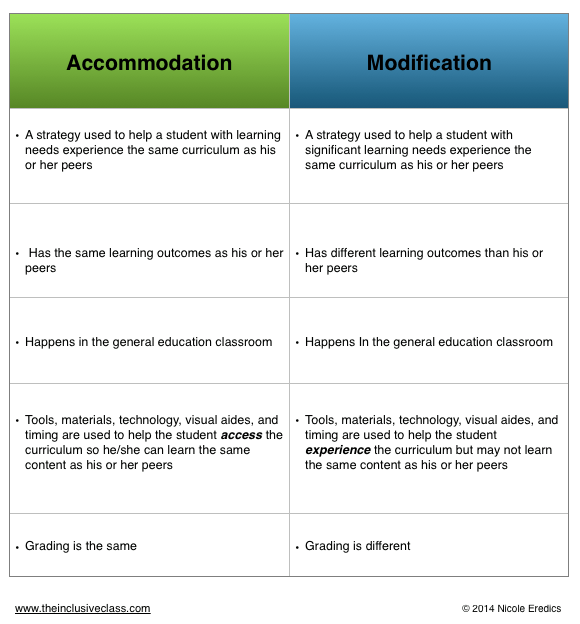This article was originally posted on Removing the Stumbling Block.
When seeking to make a classroom more inclusive, there is a lot to consider. Toss in the abundance of terminology and many teachers find themselves feeling confused and frustrated. I have been a special educator for over 20 years and read a lot in this area, and even I find myself frustrated with the way certain terms are used interchangeably.
Let’s focus on the concepts of accommodation and modification and their use in academics for individuals with disabilities as there are distinct differences to their application in a classroom setting.
Here’s a terrific overview:
 photo credit: The Inclusive Class
photo credit: The Inclusive Class
Accommodation is a strategy used to help a student with learning needs in the same curriculum as his/her peers while modification is a strategy used to help a student with significant learning needs experience the same curriculum as his/her peers.
Unfortunately, teachers in supplemental religious schools often feel untrained and ill-equipped to make such distinctions, especially when it comes to Hebrew instruction.
I can already hear them saying, “Ok, so I am teaching the Avot to my students. The Avot is the Avot. I can’t change the liturgy. How can I possibly meet the needs of a wide variety of learners?’
First, think about a different question: Why are your students learning the Avot?
I’ll come back for your answer.
Now, let’s go back to the graphic above. Here’s a little more explanation. We accommodate our students’ learning needs when we allow them to use varying modalities and/or different strategies to meet the same goals as other students. We modify lessons for those students whose goals are different than the rest of the class.
Confused? Don’t be. Here are the examples. (Remember, you are working with the Avot, but you can do this with any prayer, text or Hebrew reading assignment).
Accommodations could include:
- Providing extra time
- Listening to a recording
- Partner reading
- Breaking the prayer into manageable sections
Modifications could include:
- Identifying all of the alefs (or whatever letter(s) student may be currently learning) in the Avot
- Listening to a variety of prayers being read or chanted and student identifies the Avot
- Printing the lines of the Avot on strips of paper and student arranges them in the correct order (either from memory or while looking at the complete prayer)
- Finding the Avot each time it appears in your synagogue’s siddur (prayer book).
Before you suggest that any of those modifications won’t work or worse, that such modifications aren’t fair, let’s go back to my earlier question: Why are your students learning the Avot?
I hope that your answer included: so that they become familiar with the liturgy, so that they become comfortable with worship, so that they can participate in worship services or so that they can lead a worship service. I would agree that those are all meaningful goals for why we teach prayer in a supplemental religious school.
Now, look back at the modifications I suggest. Each one of them helps to meet those goals.
Students do not have to all be fluent Hebrew readers. Students do not have to all read & understand Hebrew perfectly. They may not even read it at all. If our goal is to help our children to develop strong Jewish identities, pride in their heritage and a love of our traditions and faith, who is to say how that should be accomplished?
Go ahead, make the accommodations. Modify your lessons. You may just help your students develop a deeper connection to their faith. You may have just helped them to cement their place in the community that supports them.
